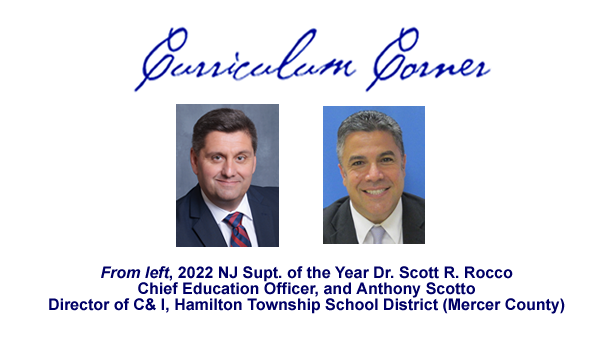- NJASA
- Curriculum Corner December 21
-
The Potential of Opening Doors after High School
Hamilton Township School District, Mercer County, is a diverse school community with about 41% of our 11,600 student population being White, 35% Hispanic, 17% Black, 4% Asian, and the remaining 3% other cultures in our 23 schools and 1 alternative program. Our free and reduced lunch students comprise about 41% of our community.
With diversity of cultures and socioeconomics in our district, our leadership team looked to our high school data to ensure our advanced placement instruction met the needs of all of our students. As opportunities to take higher level courses have the potential of opening doors after high school that some students never thought they would have access to while in school, we did not want them to miss this type of opportunity. Through educational conversations, we found students lacked an understanding of what Advanced Placement (AP) course work entailed and how AP classes could help them with their post graduation plans. We also found financial constraints limited some students' AP participation. Finally, the data showed us that the percentage of students taking AP exams was very low in all demographic areas: Hispanic (4%), Black (3%), Asian (24%), and White (15%).
To address these issues, we looked to achieve two things:
- First, we focused on developing student interest in AP classes. Some students did not understand the benefits of taking an AP class and the little they knew made many think of themselves as not being an AP student. To address this, the Office of Curriculum & Instruction, along with each high school, hosts an annual AP Potential Assembly for students and families. At this meeting, AP teachers speak about the class, the work, and the success that is possible in the AP teachers and students are encouraged to be clear and honest about the classes, the work, and why they think their class is important. One of the most powerful portions of the assembly is student testimony. Allowing potential AP students to hear from peers (and see themselves in the students sharing testimony) is a powerful motivator for students who may have never considered themselves to be an AP student.
- Second, we focused on the cost of AP exams. To address cost, each year our Curriculum & Instruction budget has an allocation to pay for all AP The Hamilton Township Board of Education supports this initiative and annually budgets $120,000 for AP exams. Whether our students take one AP course or several, they do not need to worry about the financial burden it may place on their family.
The AP initiative started three years ago and enrollment in AP classes in year one almost doubled (354 to 703), exams taken more than doubled (556 to 1204), and the students who received a 3+ on the exam also jumped (189 to 257). When we looked at the data a little closer, we found that between 2017, the year before our AP efforts, and 2020, our most recent year of complete data, AP enrollment amongst our 11th and 12th graders increased in each student demographic category; our Asian students has increased from 24% to 39%, Black/African-American students from 3% to 15%, Hispanic students from 4% to 15%, and our White students from 15% to 37%.
For more information about our program, please visit the AP section of our Curriculum webpage:
If you are interested in launching an AP Potential Program in your district, feel free to contact us for more information.
Scott Rocco, Ed.D, Chief Education Officer, Hamilton Township School District
Anthony Scotto, Director of C & I, Hamilton Township School District
- First, we focused on developing student interest in AP classes. Some students did not understand the benefits of taking an AP class and the little they knew made many think of themselves as not being an AP student. To address this, the Office of Curriculum & Instruction, along with each high school, hosts an annual AP Potential Assembly for students and families. At this meeting, AP teachers speak about the class, the work, and the success that is possible in the AP teachers and students are encouraged to be clear and honest about the classes, the work, and why they think their class is important. One of the most powerful portions of the assembly is student testimony. Allowing potential AP students to hear from peers (and see themselves in the students sharing testimony) is a powerful motivator for students who may have never considered themselves to be an AP student.



